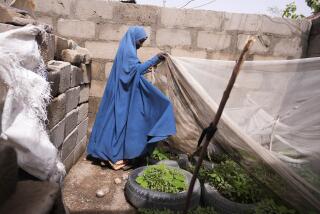Third World Debt Is a Real Killer : Children Are Dying as Bankruptcy Derails Development
- Share via
Far from the spirit of Christmas and department store check-out lines, 900 million people, mainly women and children, are worse off today than in 1979, the United Nations-declared Year of the Child. Forty years of progress in the developing world is now threatened not by insurmountable medical challenges but by mounting debt payments that drain funds away from essential health and human services. And it is children who are the greatest victims. The total debt of the developing world is now more than 1,000 billion dollars. In many countries the annual payments of interest and capital amount to more than the total of all new aid and loans that are being received each year. On average, these payments now claim almost 25% of the developing world’s export revenues.
This information is of great concern to the people at the United Nations Children’sFund. After all, their business is children, and they have been successful. Even as the world became mired in financial crisis, remarkable achievements took place: The annual child death toll was reduced by 2.5 million, and much larger numbers of children were protected through widespread immunization, oral rehydration therapy and other measures.
But now the heavy debt payments have reversed progress in the Caribbean, Africa, Latin America and parts of Asia, and in some countries infant mortality rates are rising after many years of steady decline. Approximately half a million children will have died in 1988 as a result of the debt crisis and the slowing of development alone.
The burden has fallen disproportionately on the poorest sector of these countries, on peoplewho have little voice in their governments’ political process. In the 37 poorest nations in the world, per-capita spending on health care has fallen by 50%, on education by 25%. And the poor cannot buy alternative services privately. In fact, if the momentum for child survival is not maintained, 18 million children under age 5 will die annually by the year 2000.
The derailment of development is immoral when simple, inexpensive means exist to save these young lives.
Furthermore, it is not in our own interest to allow economic policies that perpetuate illness, death and illiteracy in the developing world. The United States in particular, with its own staggering $500-billion debt and a $150-billion-a-year trade deficit, cannot afford policies that prevent the economic growth of developing countries. By not investing in their human resources, we invite their continued dependence. And we rob ourselves of any return on our original investment. The creation of jobs and services in Africa, Asia and Latin America will create new markets and new demand for our products. Meanwhile, the recession in the developing world can be estimated to have cost the United States tens of billions a year in lost exports, the equivalent of more than 1 million lost American jobs.
A broad consensus of international opinion suggests that three policy measures are essential if developing countries are to get back on the course of economic growth. First, an average 30% of their international debt must be canceled; this would increase their national incomes and their demand for exports and make them more able to repay their remaining debt. In addition, industrial nations must open their trade channels to more imports from the developing world. Finally, there must be an increase in “real aid” to developing countries. “Real aid” is not allocated to countries for political or strategic expedience; rather, it is earmarked for the poorest segment of their populations, particularly women and children, whose welfare will determine their countries’ future productivity and economic growth. Essential services like clean water, literacy, immunization and basic nutritional sustenance must not be ignored while building dams and bridges.
After World War II America undertook the economic resurrection of a devastated Europe as both a moral commitment and a pragmatic investment, pouring 2% of the U.S. gross national product into aid and laying the foundation for two decades of unprecedented world economic growth. Faced with a similar challenge today, when U.S. wealth is 2 1/2 times greater, we give only 0.22% of GNP in overseas aid--less than any other major industrial nation. It would cost the industrialized world as a whole an extra $50 billion annually to put the developing world on its feet. This cannot be considered an impossible sum when military expenditure swallows the same amount every four weeks.
As for the children: It is simply no longer necessary for 40,000 young children to die every day in the developing world and for so many millions more to live on with ill health and poor growth. The prospect of an increase is more horrifying still. Today the world is both aware of the tragedy of babies dying unnecessarily and capable of preventing it. It is unconscionable for us not to act. Former President Julius Nyerere of Tanzania put it this way: “Must we starve our children to pay our debts?” Clearly, ethics must march with awareness, morality with capacity.
More to Read
Sign up for Essential California
The most important California stories and recommendations in your inbox every morning.
You may occasionally receive promotional content from the Los Angeles Times.










